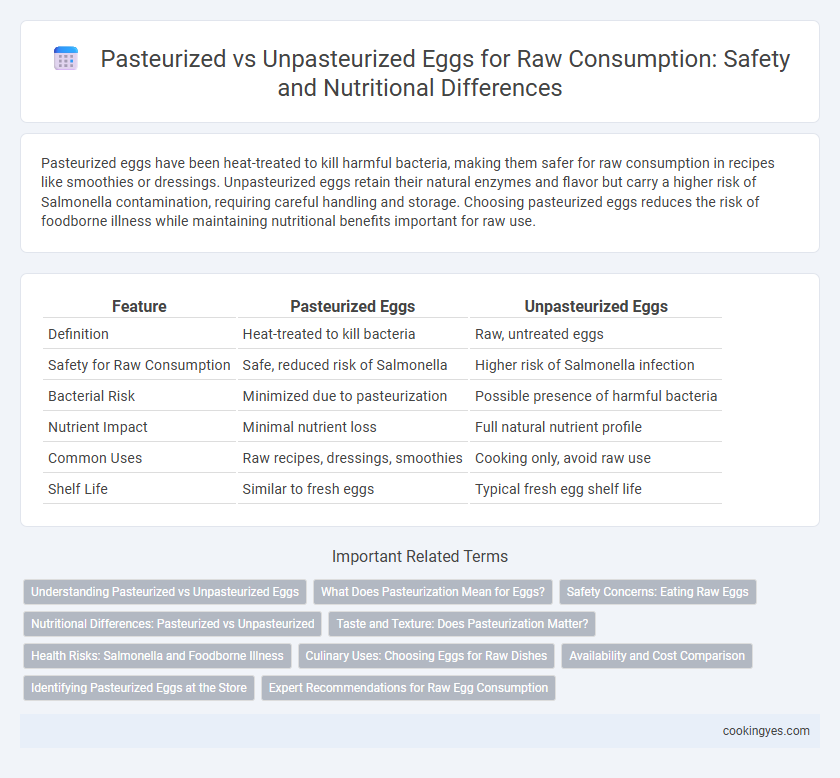Pasteurized eggs have been heat-treated to kill harmful bacteria, making them safer for raw consumption in recipes like smoothies or dressings. Unpasteurized eggs retain their natural enzymes and flavor but carry a higher risk of Salmonella contamination, requiring careful handling and storage. Choosing pasteurized eggs reduces the risk of foodborne illness while maintaining nutritional benefits important for raw use.
Table of Comparison
| Feature | Pasteurized Eggs | Unpasteurized Eggs |
|---|---|---|
| Definition | Heat-treated to kill bacteria | Raw, untreated eggs |
| Safety for Raw Consumption | Safe, reduced risk of Salmonella | Higher risk of Salmonella infection |
| Bacterial Risk | Minimized due to pasteurization | Possible presence of harmful bacteria |
| Nutrient Impact | Minimal nutrient loss | Full natural nutrient profile |
| Common Uses | Raw recipes, dressings, smoothies | Cooking only, avoid raw use |
| Shelf Life | Similar to fresh eggs | Typical fresh egg shelf life |
Understanding Pasteurized vs Unpasteurized Eggs
Pasteurized eggs are gently heated to eliminate harmful bacteria like Salmonella, making them safer for raw consumption in recipes such as homemade mayonnaise and Caesar dressing. Unpasteurized eggs, however, retain their natural enzymes and flavors but carry a higher risk of bacterial contamination, especially when consumed raw or undercooked. Choosing pasteurized eggs reduces foodborne illness risk while maintaining similar culinary properties required for dishes involving raw egg ingredients.
What Does Pasteurization Mean for Eggs?
Pasteurization of eggs involves heating them to a precise temperature to eliminate harmful bacteria like Salmonella without cooking the egg, making them safer for raw consumption. This process preserves the egg's nutritional value and texture while significantly reducing the risk of foodborne illness. Pasteurized eggs are recommended for recipes that use raw or lightly cooked eggs, such as homemade mayonnaise, hollandaise sauce, and certain desserts.
Safety Concerns: Eating Raw Eggs
Consuming pasteurized eggs significantly reduces the risk of Salmonella infection compared to unpasteurized eggs, which can harbor harmful bacteria on the shell or inside. Pasteurization involves heating eggs to a specific temperature that kills pathogens while maintaining the egg's raw qualities, making them safer for dishes like homemade mayonnaise or egg-based desserts. Unpasteurized eggs are more prone to bacterial contamination and should be avoided in raw or lightly cooked recipes to minimize foodborne illness risks.
Nutritional Differences: Pasteurized vs Unpasteurized
Pasteurized eggs undergo heat treatment that reduces bacterial contamination while retaining most of the original nutrients, with minimal loss of vitamins such as B12 and riboflavin. Unpasteurized eggs maintain their natural nutrient profile, including higher levels of certain enzymes and antioxidants, but carry a higher risk of Salmonella infection. Nutritional differences between pasteurized and unpasteurized eggs are generally minor, making pasteurized eggs a safer choice for raw consumption without significant compromise in vitamin and protein content.
Taste and Texture: Does Pasteurization Matter?
Pasteurized eggs maintain a slightly firmer texture with a more consistent taste, making them ideal for raw consumption in recipes like dressings and sauces. Unpasteurized eggs offer a richer, creamier mouthfeel and a more pronounced egg flavor, which some consumers prefer for raw dishes. The pasteurization process slightly alters the surface proteins, moderating texture without significantly impacting overall flavor.
Health Risks: Salmonella and Foodborne Illness
Consuming pasteurized eggs significantly reduces the risk of Salmonella infection and associated foodborne illnesses due to the heat treatment process that kills harmful bacteria. Unpasteurized eggs, commonly used in raw or undercooked recipes, carry a higher risk of contamination with Salmonella enterica, posing serious health threats especially to immunocompromised individuals, pregnant women, and young children. Safe handling and proper storage are critical for both types, but pasteurization remains the most effective method to minimize microbial hazards in raw egg consumption.
Culinary Uses: Choosing Eggs for Raw Dishes
Pasteurized eggs are safer for raw consumption in culinary uses such as homemade mayonnaise, Caesar dressing, and mousse because the pasteurization process eliminates harmful bacteria without cooking the egg. Unpasteurized eggs provide richer flavor and texture preferred in traditional dishes like classic French sauces and certain desserts but carry a higher risk of salmonella contamination. Chefs often prioritize pasteurized eggs when preparing raw or lightly cooked recipes to ensure food safety without compromising taste and consistency.
Availability and Cost Comparison
Pasteurized eggs are widely available in most supermarkets and tend to be priced higher due to the additional safety processing involved, making them a preferred choice for raw consumption in recipes like mayonnaise or Caesar dressing. Unpasteurized eggs are generally less expensive and easier to find at local farms or farmers' markets but carry a higher risk of salmonella contamination when consumed raw. Consumers weighing availability and cost should consider pasteurized eggs for safer raw usage despite the premium price.
Identifying Pasteurized Eggs at the Store
Pasteurized eggs undergo a controlled heat process to eliminate harmful bacteria like Salmonella, making them safer for raw consumption compared to unpasteurized eggs. In stores, pasteurized eggs are often clearly labeled, sometimes marked with a "pasteurized" sticker or housed in distinctive cartons indicating their safety for raw use. Checking for these labels ensures you select eggs that meet strict safety standards, reducing the risk of foodborne illness when consuming raw or undercooked eggs.
Expert Recommendations for Raw Egg Consumption
Experts emphasize consuming pasteurized eggs to reduce the risk of Salmonella infection associated with raw eggs. Pasteurization involves heating eggs to a specific temperature that kills harmful bacteria without cooking the egg, making them safer for dishes like homemade mayonnaise or raw protein shakes. Unpasteurized eggs pose a higher health risk, particularly for vulnerable groups such as pregnant women, young children, and the elderly.
Pasteurized vs Unpasteurized for raw consumption Infographic

 cookingyes.com
cookingyes.com